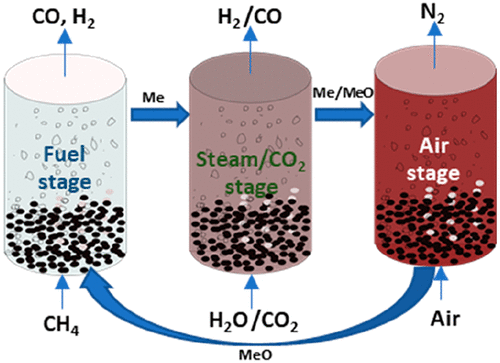当前位置:
X-MOL 学术
›
Ind. Eng. Chem. Res.
›
论文详情
Our official English website, www.x-mol.net, welcomes your feedback! (Note: you will need to create a separate account there.)
Combined Syngas and Hydrogen Production using Gas Switching Technology
Industrial & Engineering Chemistry Research ( IF 4.2 ) Pub Date : 2021-02-28 , DOI: 10.1021/acs.iecr.0c04335 Ambrose Ugwu 1 , Abdelghafour Zaabout 2 , Felix Donat 3 , Geert van Diest 4 , Knuth Albertsen 4 , Christoph Müller 3 , Shahriar Amini 1, 2, 5
Industrial & Engineering Chemistry Research ( IF 4.2 ) Pub Date : 2021-02-28 , DOI: 10.1021/acs.iecr.0c04335 Ambrose Ugwu 1 , Abdelghafour Zaabout 2 , Felix Donat 3 , Geert van Diest 4 , Knuth Albertsen 4 , Christoph Müller 3 , Shahriar Amini 1, 2, 5
Affiliation

|
This paper focuses on the experimental demonstration of a three-stage GST (gas switching technology) process (fuel, steam/CO2, and air stages) for syngas production from methane in the fuel stage and H2/CO production in the steam/CO2 stage using a lanthanum-based oxygen carrier (La0.85Sr0.15Fe0.95Al0.05O3). Experiments were performed at temperatures between 750–950 °C and pressures up to 5 bar. The results show that the oxygen carrier exhibits high selectivity to oxidizing methane to syngas at the fuel stage with improved process performance with increasing temperature although carbon deposition could not be avoided. Co-feeding CO2 with CH4 at the fuel stage reduced carbon deposition significantly, thus reducing the syngas H2/CO molar ratio from 3.75 to 1 (at CO2/CH4 ratio of 1 at 950 °C and 1 bar). The reduced carbon deposition has maximized the purity of the H2 produced in the consecutive steam stage thus increasing the process attractiveness for the combined production of syngas and pure hydrogen. Interestingly, the cofeeding of CO2 with CH4 at the fuel stage showed a stable syngas production over 12 hours continuously and maintained the H2/CO ratio at almost unity, suggesting that the oxygen carrier was exposed to simultaneous partial oxidation of CH4 with the lattice oxygen which was restored instantly by the incoming CO2. Furthermore, the addition of steam to the fuel stage could tune up the H2/CO ratio beyond 3 without carbon deposition at H2O/CH4 ratio of 1 at 950 °C and 1 bar; making the syngas from gas switching partial oxidation suitable for different downstream processes, for example, gas-to-liquid processes. The process was also demonstrated at higher pressures with over 70% fuel conversion achieved at 5 bar and 950 °C.
中文翻译:

利用气体转换技术联合生产合成气和氢气
本文着重于三阶段GST(气体转换技术)过程(燃料,蒸汽/ CO 2和空气阶段)的实验演示,该过程用于在燃料阶段从甲烷生产合成气,在蒸汽/过程中生产H 2 / CO。使用镧基氧载体(La 0.85 Sr 0.15 Fe 0.95 Al 0.05 O 3)的CO 2级。实验是在750–950°C的温度和最高5 bar的压力下进行的。结果表明,尽管不能避免积碳,但氧载体在燃料阶段对甲烷氧化为合成气具有很高的选择性,并随着温度的升高而改善了工艺性能。共同进料2在燃料级使用CH 4可以显着减少碳沉积,从而将合成气H 2 / CO摩尔比从3.75降低到1(在950°C和1 bar的CO 2 / CH 4比为1的情况下)。减少的碳沉积使在连续蒸汽阶段中产生的H 2的纯度最大化,从而提高了合成气和纯氢联合生产的工艺吸引力。有趣的是,在燃料阶段将CO 2与CH 4共同进料显示连续12小时稳定产生合成气并保持H 2/ CO比几乎为1,表明氧载体同时受到CH 4的部分氧化和晶格氧的影响,晶格氧被进入的CO 2立即还原。此外,在燃料阶段添加蒸汽可以将H 2 / CO比率调高至3以上,而在950°C和1 bar的H 2 O / CH 4比率为1时不会积碳。使来自气体转换部分氧化的合成气适用于不同的下游过程,例如气-液过程。还证明了该方法在较高的压力下,在5 bar和950°C时可实现70%以上的燃料转化率。
更新日期:2021-03-10
中文翻译:

利用气体转换技术联合生产合成气和氢气
本文着重于三阶段GST(气体转换技术)过程(燃料,蒸汽/ CO 2和空气阶段)的实验演示,该过程用于在燃料阶段从甲烷生产合成气,在蒸汽/过程中生产H 2 / CO。使用镧基氧载体(La 0.85 Sr 0.15 Fe 0.95 Al 0.05 O 3)的CO 2级。实验是在750–950°C的温度和最高5 bar的压力下进行的。结果表明,尽管不能避免积碳,但氧载体在燃料阶段对甲烷氧化为合成气具有很高的选择性,并随着温度的升高而改善了工艺性能。共同进料2在燃料级使用CH 4可以显着减少碳沉积,从而将合成气H 2 / CO摩尔比从3.75降低到1(在950°C和1 bar的CO 2 / CH 4比为1的情况下)。减少的碳沉积使在连续蒸汽阶段中产生的H 2的纯度最大化,从而提高了合成气和纯氢联合生产的工艺吸引力。有趣的是,在燃料阶段将CO 2与CH 4共同进料显示连续12小时稳定产生合成气并保持H 2/ CO比几乎为1,表明氧载体同时受到CH 4的部分氧化和晶格氧的影响,晶格氧被进入的CO 2立即还原。此外,在燃料阶段添加蒸汽可以将H 2 / CO比率调高至3以上,而在950°C和1 bar的H 2 O / CH 4比率为1时不会积碳。使来自气体转换部分氧化的合成气适用于不同的下游过程,例如气-液过程。还证明了该方法在较高的压力下,在5 bar和950°C时可实现70%以上的燃料转化率。


























 京公网安备 11010802027423号
京公网安备 11010802027423号